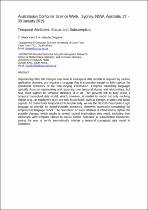JavaScript is disabled for your browser. Some features of this site may not work without it.
- ResearchSpace
- →
- Research Publications/Outputs
- →
- Conference Publications
- →
- View Item
| dc.contributor.author |
Keet, CM

|
|
| dc.contributor.author |
Nasubo Ongoma, EA

|
|
| dc.date.accessioned | 2016-02-23T09:08:43Z | |
| dc.date.available | 2016-02-23T09:08:43Z | |
| dc.date.issued | 2015-01 | |
| dc.identifier.citation | Keet, CM and Nasubo Ongoma, EA. 2015. Temporal Attributes: their Status and Subsumption. Australasian Computer Science Week, Sydney, NSW, Australia, 27 - 30 January 2015 | en_US |
| dc.identifier.uri | http://pubs.cs.uct.ac.za/archive/00001003/ | |
| dc.identifier.uri | http://www.meteck.org/files/TempAttAPCCM15.pdf | |
| dc.identifier.uri | http://hdl.handle.net/10204/8412 | |
| dc.description | Australasian Computer Science Week, Sydney, NSW, Australia, 27 - 30 January 2015. Due to copyright restrictions, the attached PDF file only contains the abstract of the full text item. For access to the full text item, please consult the publisher's website | en_US |
| dc.description.abstract | Representing data that changes over time in conceptual data models is required by various application domains, and requires a language that is expressive enough to fully capture the operational semantics of the time-varying information. Temporal modelling languages typically focus on representing and reasoning over temporal classes and relationships, but have scant support for temporal attributes, if at all. This prevents one to fully utilise a temporal conceptual data model, which, however, is needed to model not only evolving objects (e.g., an employee's role), but also its attributes, such as changes in salary and bonus payouts. To characterise temporal attributes precisely, we use the DLRUS Description Logic language to provide its model-theoretic semantics, therewith essentially completing the temporal ER language ERVT. The new notion of status attribute is introduced to capture the possible changes, which results in several logical implications they entail, including their interaction with temporal classes to ensure correct behaviour in subsumption hierarchies, paving the way to verify automatically whether a temporal conceptual data model is consistent. | en_US |
| dc.language.iso | en | en_US |
| dc.publisher | Australian Computer Society, Inc | en_US |
| dc.relation.ispartofseries | Workflow;15634 | |
| dc.subject | Temporal conceptual data model | en_US |
| dc.subject | Temporal attributes | en_US |
| dc.subject | Dynamic data | en_US |
| dc.subject | Description logics | en_US |
| dc.title | Temporal Attributes: their Status and Subsumption | en_US |
| dc.type | Conference Presentation | en_US |
| dc.identifier.apacitation | Keet, C., & Nasubo Ongoma, E. (2015). Temporal Attributes: their Status and Subsumption. Australian Computer Society, Inc. http://hdl.handle.net/10204/8412 | en_ZA |
| dc.identifier.chicagocitation | Keet, CM, and EA Nasubo Ongoma. "Temporal Attributes: their Status and Subsumption." (2015): http://hdl.handle.net/10204/8412 | en_ZA |
| dc.identifier.vancouvercitation | Keet C, Nasubo Ongoma E, Temporal Attributes: their Status and Subsumption; Australian Computer Society, Inc; 2015. http://hdl.handle.net/10204/8412 . | en_ZA |
| dc.identifier.ris | TY - Conference Presentation AU - Keet, CM AU - Nasubo Ongoma, EA AB - Representing data that changes over time in conceptual data models is required by various application domains, and requires a language that is expressive enough to fully capture the operational semantics of the time-varying information. Temporal modelling languages typically focus on representing and reasoning over temporal classes and relationships, but have scant support for temporal attributes, if at all. This prevents one to fully utilise a temporal conceptual data model, which, however, is needed to model not only evolving objects (e.g., an employee's role), but also its attributes, such as changes in salary and bonus payouts. To characterise temporal attributes precisely, we use the DLRUS Description Logic language to provide its model-theoretic semantics, therewith essentially completing the temporal ER language ERVT. The new notion of status attribute is introduced to capture the possible changes, which results in several logical implications they entail, including their interaction with temporal classes to ensure correct behaviour in subsumption hierarchies, paving the way to verify automatically whether a temporal conceptual data model is consistent. DA - 2015-01 DB - ResearchSpace DP - CSIR KW - Temporal conceptual data model KW - Temporal attributes KW - Dynamic data KW - Description logics LK - https://researchspace.csir.co.za PY - 2015 T1 - Temporal Attributes: their Status and Subsumption TI - Temporal Attributes: their Status and Subsumption UR - http://hdl.handle.net/10204/8412 ER - | en_ZA |






